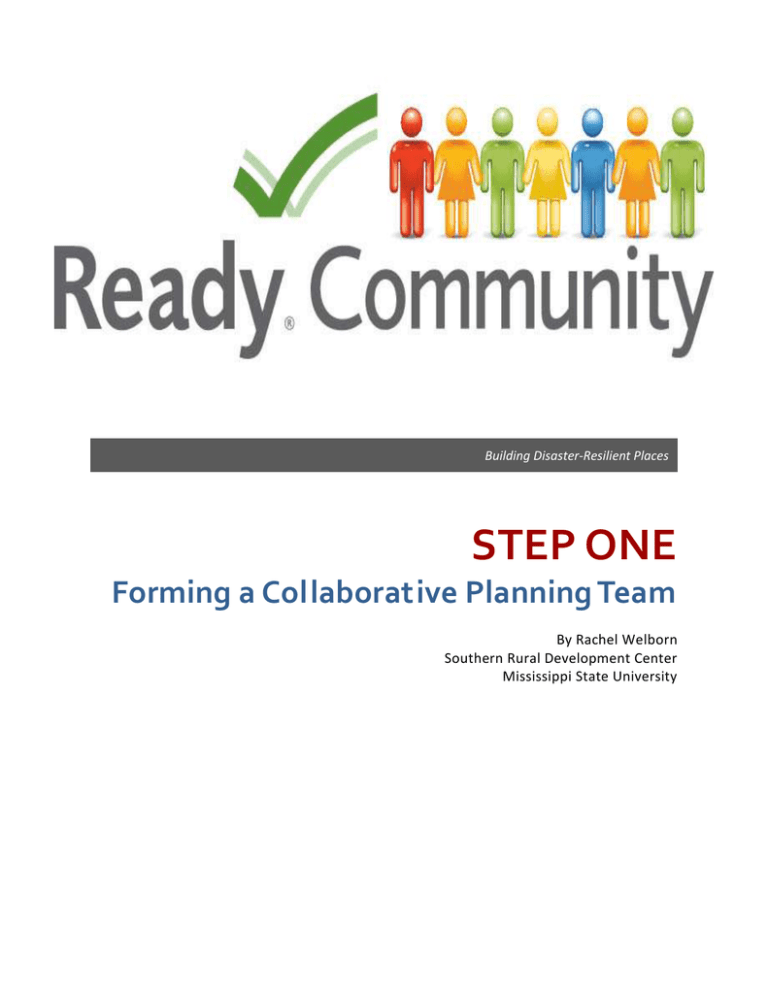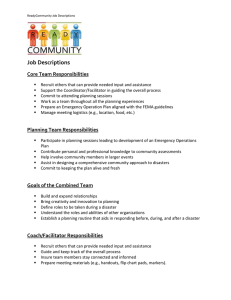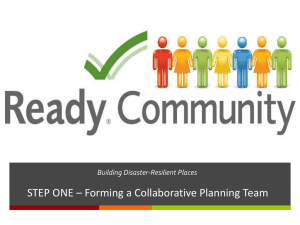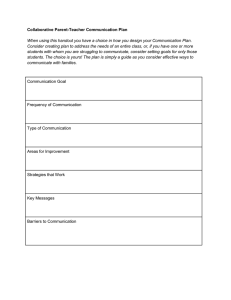Facilitator Guide
advertisement

Building Disaster-Resilient Places STEP ONE Forming a Collaborative Planning Team By Rachel Welborn Southern Rural Development Center Mississippi State University This facilitator’s guide outlines the content, activities, and handouts that should be used to teach this section. Refer to this document for detailed guidance on how to deliver ReadyCommunity Step One. ReadyCommunity Facilitator’s Guide – STEP ONE: Forming a Collaborative Planning Team 2 STEP ONE Forming a Collaborative Planning Team Overview When a large-scale disaster strikes a community, everyone is impacted in some way. Effective responses happen when the entire community understands how to work together efficiently with shared goals, clearly defined roles, and effective communication. This step helps set the stage for planning that facilitates timely, coordinated community-wide responses to complex situations. The first segment, Pre-Planning Meeting, describes the steps the facilitator will discuss with the community project point person in preparation for the ReadyCommunity process. The first step in ReadyCommunity involves forming a planning team and designing a plan for involving the community. Step One focuses specifically on the roles and responsibilities of planning team members, with an emphasis on identifying and inviting key community members into the planning process. Finally, it defines the important role that community members play along the way. Objectives This Step will help facilitate: Identifying a planning team Designing a recruitment message to foster participation Understanding the importance of engaging the larger community in the process Estimated Time to Complete Step One Activities Pre-Planning Meeting One hour Step One–Part A Two hours References to FEMA’s CPG 101 Pages 4-2 to 4-6 ReadyCommunity Facilitator’s Guide – STEP ONE: Forming a Collaborative Planning Team 3 Pre-Planning Meeting All planning processes need a starting point and usually, a point person that can help coordinate the local planning process. For the development of an emergency plan, the local emergency manager is the most probable person for this role, but that may vary by community. The community coach should arrange an initial meeting with the identified point person to plan for the first team meeting. If he/she already has commitment from other community leaders/responders, this first meeting can be conducted with a small group. Advance Preparation Contact local point person Supplies Needed Calendar Map of county/community Ready Community Overview Pre-Planning Meeting Agenda Support Documents ReadyCommunity Overview Pre-Planning Meeting Agenda Introductory Meeting Advanced Preparation Notes Estimated Time to Complete 60 minutes Instructions Step 1: Arrange an appointment with the local point person. Plan for a one-hour meeting. Step 2: During the meeting, use the Pre-Planning Meeting Agenda as a guide to help think through the steps to preparing for ReadyCommunity. Make sure that the point person has a clear understanding of the process and expectations. Work together to identify the potential core team members, tentative timeline, invitation plan, and logistics for the first meeting. Step 3: Work with the local point person to invite potential participants and confirm their attendance at the Introductory Planning Meeting. Step 4: Work with the local point person to arrange all logistics for the Introductory Planning Meeting. NOTE: See Advanced Preparation notes on next page. ReadyCommunity Facilitator’s Guide – STEP ONE: Forming a Collaborative Planning Team 4 Forming a Collaborative Planning Team This meeting should include the people in the community that are likely to comprise the Core Team along with the potential Planning Team members, if possible. During this meeting, the coach will explain the process and specific roles that each group plays in the process. The purpose will be to determine the level of commitment from each attendee to the planning process. Advanced Preparation One Month Prior Visit with local point person o Go over logistics for first session o Determine who will be invited and who will be responsible for invitations o Discuss the homework/preparation that is needed History of planning in the region Bring copies of any community plans that have been prepared Visit meeting location o Find out if you are allowed to post charts to the walls o Determine the best room set up with type of tables available. It is recommended that you arrange the room so that participants can face each other if possible (such as a U shape rather than classroom style) If a meal or refreshments will be served, make plans for these Two Weeks Prior Follow up with local point person o Confirm final count o Discuss any questions/concerns that may have surfaced Get names of attendees, send out an email to: o Confirm date, time, location o Go over what they should expect, their responsibilities o Introduce the training team if not already done Confirm food and beverages, if being provided, with local point person Double check logistical arrangements Print handouts (See “Supplies Needed” on next page) Add your contact information to the final slide in PowerPoint “ReadyCommunity – Step One” Day of Event Arrive at meeting place at least 45 minutes prior to meeting in order to: Set up PowerPoint equipment. Have the first slide displayed as participants arrive. Arrange tables and chairs so that participants can be face-to-face. A U-shape works well with the projector screen in the opening of the U. Prepare a sign-in table so that you can ensure you have accurate contact information for all participants. Set up refreshments (optional). Set ReadyCommunity Overviews on the tables. ReadyCommunity Facilitator’s Guide – STEP ONE: Forming a Collaborative Planning Team 5 Supplies Needed Handout 1 – ReadyCommunity Overview Handout 2 – Job Descriptions Handout 3 – Designing a Win-Win Invitation Handout 4 – Are We Ready? Handout – PowerPoint (optional) Computer Projector Screen or blank wall Extension cord Flip chart & easel Markers Sign in sheet Nametags and name tents (unless all participants are well acquainted) Calendar Map of county/community Two signs: “Ready” and “Not Ready” Support Documents Comprehensive Planning Guide (CPG 101) ReadyCommunity Facilitator’s Guide – STEP ONE: Forming a Collaborative Planning Team 6 STEP ONE Detailed Instruction Slide 1 ReadyCommunity Welcome slide – have up when participants enter the room. Welcome participants and allow time for introductions if participants are not already acquainted. Warm up: Ask each person to share the following information: Name (If they are not already acquainted) Occupation The most recent disaster they can recall One thing that went well in responding to the disaster One thing that could have been better Supplies/Materials Handout 1 – ReadyCommunity Overview (Place one copy at each seat before participants arrive) Estimated Time 10-20 min. (depending on size of the group) Record the “went well” and “could have been better” responses on separate charts. After everyone has responded, ask for a volunteer to identify common themes on each sheet. ReadyCommunity Facilitator’s Guide – STEP ONE: Forming a Collaborative Planning Team 7 Slide 2 A Mini-Quiz This tiny mini-quiz is designed to set the stage for the planning process. Many individuals may not be aware that FEMA recommends a minimum of 3 days’ supplies on hand to sustain you and your family. The first mouse click will bring up the question. Get responses from the participants. 2 A Mini-Quiz What is minimum amount of time you should be prepared to survive on your own in a disaster? After hearing from a few people, show the answer (2nd mouse click.) Often the standard is stated in hours. The 3rd click of the mouse translates that into days. The final click of the mouse gives an easy rhyme to help people internalize the recommendation: The first three (days) is on me. 72 hours = 3 days The first 3 is on me Supplies/Materials Estimated Time 5 min. The reality, though, is that for rural places involved in a large scale disaster that covers a lot of territory, three days may not be enough. The next slide continues this thought. ReadyCommunity Facilitator’s Guide – STEP ONE: Forming a Collaborative Planning Team 8 STEP ONE Detailed Instruction Slide 3 Rural Challenges Throughout a series of roundtable sessions with emergency managers, the challenges that rural emergency managers consistently noted are depicted here in this chart. Harder to Plan: On the one hand, emergency managers found the planning process particularly challenging as many stated that they had no dedicated staff support and that they also wore many “hats” in the community, with emergency planning typically only a part of their job responsibilities. Longer to Receive Aid: The remoteness of the communities they served made responses to disasters more challenging. Less developed rural roads and the distance between homes meant response times were increased over more metropolitan areas. Communication challenges were reported as fewer back-up systems tended to be available in these locations. During widespread disasters (such as Katrina), outside assistance usually focuses first on the places where the most people are impacted. Supplies/Materials Estimated Time 5 min. These concerns along with others identified through the year-long roundtable process have led to the ReadyCommunity initiative, designed to respond to the challenges of rural communities in assessing risks and planning for disasters with the support of a local coach and national team. ReadyCommunity Facilitator’s Guide – STEP ONE: Forming a Collaborative Planning Team 9 STEP ONE Detailed Instruction Slide 4 FEMA’s CPG 101 ReadyCommunity is based on FEMA’s Comprehensive Preparedness Guide (CPG 101). This guide is designed to provide a blueprint for successful planning. Its stated purposes are listed on this slide. ReadyCommunity aids in this process by providing these supports to the process directly aligning with the CPG 101 guidance. Supplies/Materials Estimated Time 2 min. Slide 5 What is Involved? The process follows six basic steps as outlined in CPG 101 and shown here. Today begins the journey with an exploration of Step One. (Note that we substitute the word “actions” for “objectives” in Step Three, as it is a more commonly understood term.) Supplies/Materials Estimated Time 2 min. ReadyCommunity Facilitator’s Guide – STEP ONE: Forming a Collaborative Planning Team 10 STEP ONE Detailed Instruction Slide 6 Layers of Involvement The CPG 101 outlines three layers of involvement in the community planning process. Each layer has specific roles to play. Supplies/Materials Estimated Time 5 min. Slide 7 Purpose of the Emergency Manager This slide outlines the importance of the emergency manager’s role in the planning process. ReadyCommunity should not been undertaken without involving the person(s) with legal authority over disaster planning and response. Without the involvement of that person, the planning will likely have limited success. Among the important roles that the Emergency Manager plays are: • Has the legal responsibility for overseeing emergency preparedness and response • Taps supporting resources, most of which come through government avenues • Provides expert guidance for the plan Ensures important connections between community, county, state, and federal plans ReadyCommunity Facilitator’s Guide – STEP ONE: Forming a Collaborative Planning Team Supplies/Materials Estimated Time 5 min. 11 Slide 8 Purpose of a Community Coach A community coach, or facilitator, is here to help the community work through the planning process by using focused activities to help guide the group to the end goal. Some of the specific ways a coach can assist are listed on the slide. The Community Coach: Supports the planning effort, from start to finish Helps organize the Core Team and Planning Team Facilitates the process that aids the Planning Team in preparing a plan Helps coordinate community involvement Provides links to data and expertise available through state, regional and/or national partners ReadyCommunity Facilitator’s Guide – STEP ONE: Forming a Collaborative Planning Team Supplies/Materials Handout 2 – Job Descriptions Estimated Time 1 min. 12 STEP ONE Detailed Instruction Slide 9 Core Team Responsibilities The Core Team has key leadership in organizing the input from the various avenues. This slide outlines their key responsibilities. These include: Guide the overall process Recruit others from the community to gain needed input and assistance Commit to participating in planning sessions Work as a team through the planning experiences Prepare an Emergency Operation Plan aligned with the state emergency guidelines Discussion: Who in this community/county are the ones that we would most like to include in this group? Supplies/Materials Handout 2 – Job Descriptions Estimated Time 3 min. Slide 10 Planning Team Responsibilities In support of the Core Team, the Planning Team provides key assistance and support throughout the process. Here are key roles that they play: Participate in planning sessions Contribute to community assessments Help involve community Assist in designing the emergency plan Commit to keeping the plan current Supplies/Materials Estimated Time 3 min. ReadyCommunity Facilitator’s Guide – STEP ONE: Forming a Collaborative Planning Team 13 STEP ONE Detailed Instruction Slide 11 Goals of the Planning and Core Team Working together, the Core Team and Planning Team will aim toward these five goals (see slide): 1. Build and expand relationships that may help strengthen the response efforts. 2. Bring creativity and innovation to the process. Different viewpoints and ideas can strengthen the planning process by providing a wider variety of options to consider. 3. Define roles to be taken during a disaster. When a disaster hits is not the time to try to figure out who’s who in the community. In order to respond efficiently and effectively, these roles should be planned well in advance. 4. Supplies/Materials Estimated Time 8 min. Understand the roles and abilities of other organizations. Many challenges in a disaster can be avoided or lessened by a clear understanding of who can do what in the community. Often, false expectations lead to frustration, anger, and sometimes, even added risk and danger. 5. Establish a planning routine that aids in responding before, during, and after a disaster. With strong working relationships already built during the planning process, responding to a disaster in a unified manner becomes a much easier task. Note: Small communities are less likely to be heard in the planning process as you go up the geographic scale. This effort will raise the voice of small communities so that their needs and interests can be heard at county, regional and state levels. ReadyCommunity Facilitator’s Guide – STEP ONE: Forming a Collaborative Planning Team 14 STEP ONE Detailed Instruction Slide 12 Who Should be at the Table? So, the next question is, “Who should be at the table for these planning sessions?” Note to Facilitator: This slide is a transition slide. Use slides 12-14 to lead a discussion on who else should be involved in the planning process and at what level (Core Team, Planning Team, community). List responses on a flip chart as you discuss. Supplies/Materials Flip Chart Markers Easel Estimated Time 2 min. Slide 13 FEMA Suggests… Here are the basic groups that FEMA suggests. Most communities will have someone that serves in each of these key community roles. The point is to have all key sectors that are needed to help coordinate a community-wide response joining in on the planning process. (Click to add, “Who else is missing?”) Ask participants: While this list is certainly a sound starting point, what other major sectors are present in your community? Make sure these are included: Business/industry Non-profits Faith-based organizations Elected officials ReadyCommunity Facilitator’s Guide – STEP ONE: Forming a Collaborative Planning Team Supplies/Materials Flip Chart Markers Estimated Time 10 min. 15 STEP ONE Detailed Instruction Slide 14 Considering Special Needs In addition, think about those people in your community that may have the most difficulty responding to a disaster. Ask participants: What people or groups are most likely to have difficulty responding to a disaster in your community? Who has contact with these people or groups on a regular basis? Be sure to list the answers on the flip chart. Make sure they consider these groups along with any others they may identify: Low income (bring employers of these to the planning table) Families with small children, particularly single parent households Non-English speaking Home bound Those without transportation Medically dependent (dialysis, oxygen dependent, etc.) Institutionalized individuals Elderly Individuals with disabilities Children of parents who work out of the county Supplies/Materials Flip Chart Markers Estimated Time 10 min. NOTE: Use these responses to expand on the “Who Is Missing” discussion on the previous chart. Also, save this list of special needs individuals as it is used in Step 2. ReadyCommunity Facilitator’s Guide – STEP ONE: Forming a Collaborative Planning Team 16 STEP ONE Detailed Instruction Slide 15 How to Involve Others in Planning Slide 13 shows how to create a “win-win” partnership that forms the foundation for getting others involved. Using the flip chart list generated in the previous exercise and handout 3, have the group identify the elements of the win-win partnership. For each person/group identified, determine what they would gain from participating in planning and what the planning team would gain from their participation. Supplies/Materials Handout 3 – Designing a Win-Win Invitation If the group is large enough and/or the flip chart list is long, consider dividing the group to let them work on different parts of the list. Estimated Time 15 min. Debrief and get commitments. If you divided the group into smaller teams to work, have them each report back. Then, either have a few volunteers role play an invitation to a potential partner on the list. OR divide the group into pairs and have each pair role play an invitation. Once participants are able to walk through these steps, ask for volunteers to contact each of the identified potential partners to invite them to the next meeting. Record the volunteers’ names beside the individuals. Accountability is important throughout this process. ReadyCommunity Facilitator’s Guide – STEP ONE: Forming a Collaborative Planning Team 17 STEP ONE Detailed Instruction Slide 16 When to Involve the Community The planning process suggests two community touch-points that can strengthen community disaster planning. Within Steps Two, and Six of the planning process, the community can play a significant role. Step Two, Understanding the Situation, community members can verify and strengthen the assessments. They can also giving feedback on community mapping to ensure that these accurately reflect what is happening on the ground. Step Six: Plan Implementation and Maintenance: This final event is an ideal time to educate the public on their how they can prepare as individuals or families as well as encourage volunteerism and training to promote a more sustainable community response network. Supplies/Materials Estimated Time 2 min. As we walk through those steps, we will talk about specific strategies that are effective in gaining input. ReadyCommunity Facilitator’s Guide – STEP ONE: Forming a Collaborative Planning Team 18 STEP ONE Detailed Instruction Slide 17 Are We Ready? This process is designed to help gauge how participants feel about the preparedness task at hand. Ask participants to take a moment to complete the short worksheet “Are We Ready to Plan?” Have them total their response numbers. Explain that they are to answer each question to the best of their own personal knowledge, Treat “I don’t know” as “no.” Place the two signs “Ready” and “Not Ready” on opposite sides of the room (or some reasonable distance apart to allow participants to take a position between them based on their total scores). Have participants view the space between the two signs as a continuum with “Ready” being a maximum score of 70 and “Not Ready” being a score of 14. Supplies/Materials Handout 4 – Are We Ready? Estimated Time 15 min. Ask them to all come take a place along the continuum that best represents their total score. Lead a discussion based on their positions. These questions may serve as guides: What do you observe about the group spacing (Is everyone clustered together or scattered)? What appears to be about the average “score” for readiness for the group? How do you think a lack of information or connections may influence community readiness (reference the times people didn’t know the answer to various questions.) Question for high scorers: What gives you the most hope that this project will be successful? Questions for low scorers: What is your biggest concern? What are some things we can do to raise the group’s readiness scores? ReadyCommunity Facilitator’s Guide – STEP ONE: Forming a Collaborative Planning Team 19 STEP ONE Detailed Instruction Slide 18 Questions & Discussion This final content slide serves as a debrief for the session. These key concepts listed on the slide are potential starting points for the discussion. Some of the previous exercises may have led to some additional essential next steps to promote planning readiness. Supplies/Materials Estimated Time 10 min. Slide 19 ReadyCommunity Thank participants for coming. Note to Facilitator: Be sure to include your contact information as well as the local point person’s contact information so that all participants can stay connected to the planning process. Supplies/Materials Estimated Time 5 min. ReadyCommunity Facilitator’s Guide – STEP ONE: Forming a Collaborative Planning Team 20


